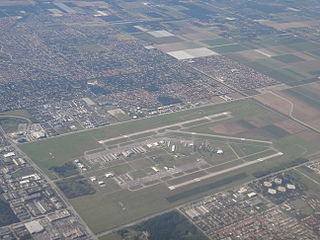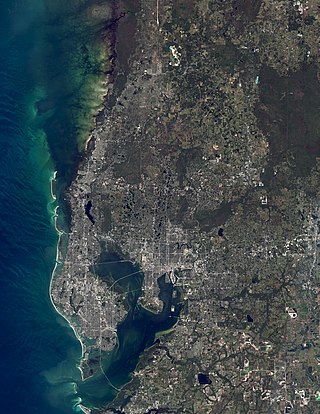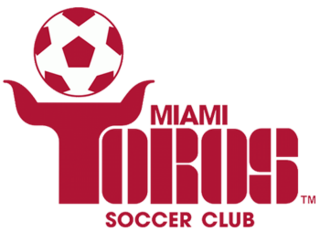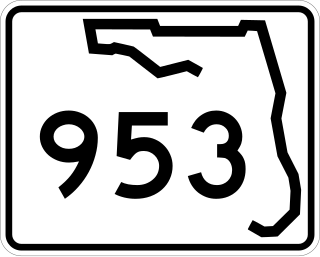
St. Petersburg is a city in Pinellas County, Florida, United States. As of the 2020 census, the population was 258,308, making it the fifth-most populous city in Florida and the second-largest city in the Tampa Bay Area, after Tampa. It is the largest city in the state that is not a county seat. Along with Clearwater, these cities are part of the Tampa–St. Petersburg–Clearwater Metropolitan Statistical Area, the second-largest in Florida with a population of around 2.8 million. St. Petersburg is on the Pinellas peninsula between Tampa Bay and the Gulf of Mexico, and is connected to mainland Florida to the north.

University Park is a neighborhood and former census-designated place (CDP) located in an unincorporated area of western Miami-Dade County, Florida, United States. It was merged into Westchester CDP for the 2020 U.S. Census. In 2010, the population was 26,995. It encompasses the Modesto A. Maidique Campus of Florida International University and the Fair Expo Center, and was the former name of the former's campus.

Florida International University (FIU) is a public research university with its main campus in the neighborhood of University Park in the Westchester CDP of unincorporated Miami-Dade County, Florida. Founded in 1965 by the Florida Legislature, the school opened its doors to students in 1972. FIU has grown to become the third-largest university in Florida and the eighth-largest public university in the United States by enrollment. FIU is a constituent part of the State University System of Florida.

Miami Executive Airport, formerly known until 2014 as Kendall-Tamiami Executive Airport, is a public airport in unincorporated Miami-Dade County, Florida, 13 miles (21 km) southwest of Downtown Miami. It is operated by the Miami-Dade Aviation Department.

The Miami Orange Bowl was an outdoor athletic stadium in Miami, Florida, from 1937 until 2008. The stadium was located in the Little Havana neighborhood west of Downtown Miami. The Miami Orange Bowl was considered a landmark and served as the home stadium for the Miami Hurricanes college football team from 1937 through 2007 and for the Miami Dolphins for the Dolphins' first 21 seasons until Joe Robbie Stadium opened in nearby Miami Gardens in 1987. The stadium also was the temporary home of the FIU Golden Panthers while its on-campus venue, now known as Riccardo Silva Stadium, underwent expansion during the 2007 season.
The Tamiami Trail is the southernmost 284 miles (457 km) of U.S. Highway 41 (US 41) from State Road 60 (SR 60) in Tampa to US 1 in Miami. A portion of the road also has the hidden designation of State Road 90 (SR 90).

The Tampa Bay area is a major metropolitan area surrounding Tampa Bay on the Gulf Coast of Florida in the United States. It includes the main cities of Tampa, St. Petersburg, and Clearwater. It is the 18th-largest metropolitan area in the United States, with a population of 3,175,275 as of the 2020 U.S. Census.

The Tampa Bay Rowdies were an American professional soccer team based in Tampa, Florida, that competed in the original North American Soccer League (NASL) from 1975 to 1984. They enjoyed broad popular support in the Tampa Bay area until the NASL folded in 1984, after which the team played in various minor indoor and outdoor leagues before finally folding on January 31, 1994. The Rowdies played nearly all of their outdoor home games at Tampa Stadium and nearly all of their indoor games at the Bayfront Center Arena in nearby St. Petersburg, Florida. Although San Diego played indoors until 1996, the Rowdies were the last surviving NASL franchise that played outdoor soccer on a regular basis.

Al Lang Stadium is a 7,500-seat sports stadium along the waterfront of downtown St. Petersburg, Florida, United States which was used almost exclusively as a baseball park for over 60 years. Since 2011, it has been the home pitch of the Tampa Bay Rowdies of the USL Championship soccer league.

The Miami Toros was a professional soccer team in the North American Soccer League from 1972 to 1976. The club was founded in 1967 as the Washington Darts, and moved to Miami, where they played the 1972 season in the NASL's Southern Division as the Miami Gatos. In 1973, the club rebranded as the Miami Toros. Their home field was at times the Miami Orange Bowl, Tamiami Field and Miami Dade College's North Campus Stadium.

Al López Field was a spring training and Minor League baseball ballpark in West Tampa, Tampa, Florida, United States. It was named for Al López, the first Tampa native to play Major League Baseball (MLB), manage an MLB team, and be enshrined in the Baseball Hall of Fame. Al López Field was built in 1954 and hosted its first spring training in 1955, when the Chicago White Sox moved their training site to Tampa from California. Al López became the White Sox's manager in 1957, and for the next three springs, he was the home manager in a ballpark named after himself. The Cincinnati Reds replaced the White Sox as Al López Field's primary tenant in 1960 and would return every spring for almost 30 years. The Tampa Tarpons, the Reds' Class-A minor league affiliate in the Florida State League, played at the ballpark every summer from 1961–1987, and many members of the Reds' Big Red Machine teams of the 1970s played there early in their professional baseball careers.

State Road 985, locally known as West 107th Avenue, FIU Avenue, and Avenue of the Americas, is a 7.604-mile (12.237 km) long north–south street in western Miami-Dade County, Florida, serving the communities of Kendall, University Park, Sweetwater, Fontainebleau, and Doral.

State Road 953, locally known as Le Jeune Road, is a 11.735 miles (18.886 km) long north–south street in Miami-Dade County, Florida running a few miles west of central Miami from U.S. Route 1 in Coral Gables to State Road 916 in Opa-locka. It is also known as West 42nd Avenue on the greater Miami grid plan and East 8th Avenue in the Hialeah grid plan.

The Tampa Bay area is home to many sports teams and has a substantial history of sporting activity. Most of the region's professional sports franchises use the name "Tampa Bay", which is the name of a body of water, not of any city. This is to emphasize that they represent the wider metropolitan area and not a particular municipality and was a tradition started by Tampa's first major sports team, the original Tampa Bay Rowdies, when they were founded in 1975.

The Fort Lauderdale–Tampa Bay rivalry, also known as the Florida Derby, refers to the suspended soccer rivalry that most recently involved the Fort Lauderdale Strikers and the Tampa Bay Rowdies, both of whom played in the North American Soccer League through the 2016 season. Over the years the rivalry has spanned more than one hundred matches across eight soccer leagues and several tournaments, and involved nine different teams from the two regions of Florida. At times it has involved players, coaches, management and fans. Even the press has fanned the rivalry's flames at times. From 2010 through 2014, the winner of the regular season series automatically won the Coastal Cup as well. The status of the rivalry beyond 2016 remains unclear because the Rowdies have since joined the United Soccer League, while the Strikers ongoing ownership and legal battles of 2016 and 2017 have left them defunct.

NASL Final 1974 was the championship match of the 1974 season, between the expansion Los Angeles Aztecs and the Miami Toros. The match was played on August 25, 1974 at the Orange Bowl, in Miami, Florida. The teams played to a, 3–3, draw, and after a short break the game moved directly to a penalty shoot-out. Los Angeles won the shoot-out, 5–3, and were crowned the 1974 champions. This was the second consecutive year that an expansion team won the NASL title

FIU Football Stadium is a college football and soccer stadium on the campus of Florida International University (FIU) in Miami, Florida. It is the home stadium of the FIU Panthers football team and the Miami FC soccer team from the USL Championship. The stadium opened in 1995 and has a seating capacity of 20,000.

The history of Florida International University, the first public institution of higher education in Miami and largest university in South Florida, began in 1965, with the introduction of a bill for the planning of the city's first state university. Florida International University was established in 1969 when it was established as a space-grant university by the Florida Legislature. Florida International is one of the youngest but the second largest university in the State University System of Florida. Florida International's opening in 1972, was the largest opening enrollment in U.S. collegiate history with 5,667 students enrolled.


















